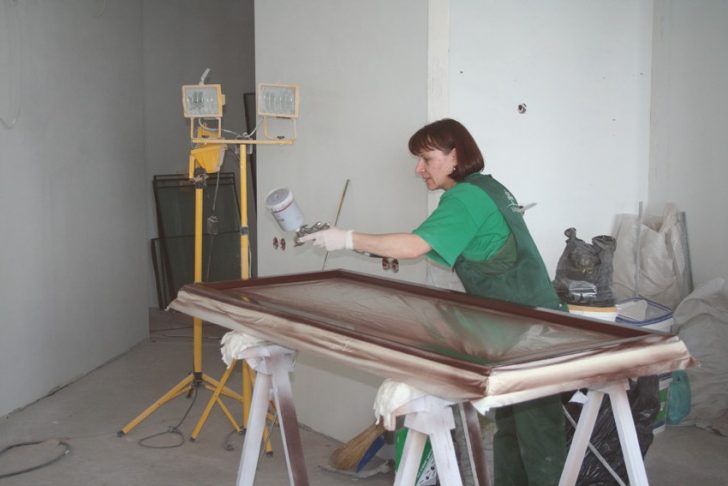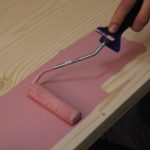What type of paint to use for staining interior doors
Table of contents:
- What kind of paint should be used while painting the door;
- The procedure of painting the door;
- How to paint the door properly;
Painting internal doors can not only renew and refresh the interior, but also protects the door from the negative influence of external factors. While choosing the paint for interior doors, keep in mind that stained surface must be practical and at the same time pleasing to your eye.
What kind of paint should be used while painting the door
Nowadays the market offers a numerous choice of tint coatings, impregnations, paints and varnishes, which can be used for painting the doors. Water-based paints are especially popular.They are safe, ecological, rather inexpensive and stable. Such enamel can be presented in different types:
- Water-emulsion (water-dispersive)
After that sort of staining the door in most cases is covered with a transparent varnish. Water-emulsion paint is odour-free; it dries up quickly and is low-costs. The majority of producers put on the market white paint for interior doors. It is up to the customer to choose color, while adding an appropriate dye.
It is water based enamel as well typically put in 2-3 layers. It penetrates and absorbs in MDF very quickly. Before applying acrylic enamel on the surface, it is necessary to carry out the clearcole of the MDF door. Quick-drying acrylic paints dry within 10-12 hours, and absolute desiccation takes no more than two days.
- Water-based thermal enamel
A long working life and good retention of the original color are principal advantages of such kind of paint. Even being under the influence of external negative factors this paint does not lose its attractiveness. Moreover, you will be able to use the interior door fully just in an hour after the staining. The odour of thermal enamel is almost imperceptible, so it will not prevent you from painting the door.
- Nitro paints
It is a very durable paint, which has distinctive reflection and unfortunately, not the very pleasant toxic odour. The vapours of nitro paints must not come into respiratory passages. Therefore, in case of using this enamel it is important to stain the surface, observing the work safety completely.
- Interior paint
In most cases interior paints are acrylic enamels with the addition of special components which let the stained object maintain its attractive outlook during the longer period. The advantage if such a paint is absence of caustic smell. Having chosen this kind of dye, you can stain the door in a few minutes. The odour-free paint for interior doors dries up very quickly.
The procedure of painting doors
Before starting the work, you have to prepare the interior doors for painting. It is necessary to obtain rollers, sponges, paints and brushes. If the old covering on the wooden door cannot be removed by common methods, you will need a special chemical solution. The procedure of work is like this:
- Remove the door from its hinges. It is better to stuff the lock grooves with cotton or cloth to secure them against paintwork, which can get inside.
- Apply the special paint-removing solution on the old covering. The solution can be applied with the help of tampons. Then wait for half an hour for substance to have effect. The best variant is technical carbolic acid.
- After half an hour the door should be washed with water and allowed to dry up thoroughly (3-5 hours are needed).
- The next step is walling the cracks, chips and other effects of the surface up. For this purpose, use the filling cement, that should be distributed on the surface evenly. It is important to let the filling cement dry completely. You can buy the filling cement of any color, but take into account the future color of wooden doors.
- After drying the door is polished with glass-paper and drying oil.
How to paint the door properly
For staining the interior wooden doors, the next instruments and materials will be needed:
- Paint and container for it;
- Brushes of different size(depending on the dimensions of the door and its relief), rollers;
- Special painting tape;
- Protective material, which can be spread under the door;
- Gloves, glass-paper.
Being equipped with the above mentioned things, you can safely set about to the process itself. It is better not to reinvent the wheel, remove the door from its hinges and place it into horizontal position on a flat surface. Painting in horizontal level will help to avoid objectionable paint burrs.
Before painting the fittings must be taken away or pasted with a special painting tape. Glass inserts (if there are any) should also be protected with a painting tape.
Depending on the door surface it is comfortable to stain the door with roller or brush. If the door is flat and does not have sockets, the roller can be used. This approach allows finishing staining more quickly and the paint will cover the door more even than while applying it with brush. The presence of decorative elements leaves no choice – the brush has to be used.
It is highly recommended to start staining the door from the left top corner, applying the paint little by little from left to right. The very first thing is about working up the sockets on the door surface. After having the main part of the door stained, you can proceed to dealing with ends. After finishing the procedure, it is necessary to take the painting tape away immediately, without allowing the paint to dry. Otherwise, the painting tape can scratch the even color.




























